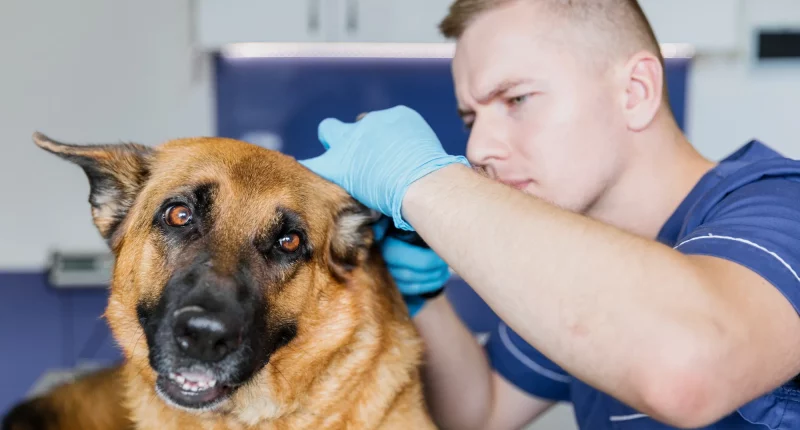Canine Parvovirus is a highly contagious viral disease that affects dogs, especially puppies. It mainly targets rapidly dividing cells, like those in the intestines, lymphoid tissues, and bone marrow, leading to symptoms like serious vomiting, diarrhea (bloody), dehydration, and a weakened immune system.
The virus is highly resistant to environmental conditions and can survive on surfaces for long periods, making it easily transmissible. Vaccination is the most effective way to prevent CPV infection, and early treatment is crucial for affected dogs to increase their chances of recovery.
Symptoms
Canine Parvovirus infection in dogs often begins with symptoms of lethargy, loss of appetite, and fever. As the virus progresses, it primarily triggers the gastrointestinal tract, leading to severe diarrhea and vomiting. The diarrhea is typically profuse and may contain blood, resulting in rapid dehydration. This can cause the dog’s gums to appear dry and pale, indicating oxygenation and poor circulation. Affected dogs might also experience abdominal pain and bloating, leading to discomfort and a hunched posture.
In addition to gastrointestinal symptoms, CPV can compromise the immune system by decreasing the number of white blood cells, which weakens the dog’s ability to fight off secondary infections. This immunosuppression can make dogs more susceptible to other bacterial and viral infections, complicating the course of the disease.
Puppies and young dogs are particularly vulnerable due to their developing immune systems. Without prompt veterinary care, the severe dehydration and secondary infections caused by CPV can be fatal. Early detection and treatment are crucial to improving the prognosis for infected dogs.
Treatment
Treatment for Canine Parvovirus mainly focuses on supportive care, as there is no specific antiviral cure for the virus itself. The main aims are to manage symptoms, prevent complications, and support the immune system while the dog fights off the infection.
Hospitalization is often necessary, especially for severe cases. Key components of treatment include intravenous fluids to address lack of hydration, electrolyte imbalances, and hypoglycemia. This rehydration therapy is crucial for stabilizing the dog, as vomiting and diarrhea can quickly lead to life-threatening fluid loss.
Anti-diarrheal and anti-nausea medicines may be administered to control gastrointestinal symptoms, while antibiotics are often recommended to prevent or treat secondary bacterial infections that can arise due to the weakened immune system.
Nutritional support is also an important aspect of treatment, as CPV can cause significant weight loss and malnutrition. In some cases, feeding tubes may be used if the dog cannot eat on its own. Isolation from other dogs is necessary to prevent the transmission of the virus, as CPV is highly contagious.
Recovery from CPV depends on the seriousness of the symptoms and the promptness of treatment. While some dogs may recover fully with appropriate care, others, particularly young puppies or those with severe symptoms, may face a more challenging prognosis. Vaccination is the most effective way to prevent CPV, and ensuring that dogs receive their vaccinations on schedule is important for protecting them from this potentially deadly disease.
Causes
Canine Parvovirus is caused by a highly contagious virus that primarily spreads through direct contact with infected dogs or contaminated environments. The virus is shed in high quantities in the feces of infected dogs, and even small amounts of fecal matter can contaminate surfaces, food, water, and the environment.
CPV can survive for extended periods outside the host, making it challenging to eradicate from contaminated areas. Puppies and unvaccinated dogs are particularly susceptible due to their weaker immune systems and lack of prior exposure to the virus.
Transmission of CPV often occurs in environments where dogs are in close contact, such as shelters, boarding facilities, and dog parks. The virus can also be spread indirectly via contaminated clothing, shoes, or equipment. Because CPV is highly resistant to common disinfectants and can persist in the environment for months, thorough cleaning and disinfection are crucial for controlling outbreaks.
Vaccination remains the most effective preventive measure, protecting dogs from infection and reducing the spread of the virus in canine populations.
Diagnosis
Diagnosing Canine Parvovirus involves a combination of clinical examination and laboratory tests. Veterinarians often suspect CPV based on symptoms like severe diarrhea, vomiting, and dehydration, especially in unvaccinated puppies or dogs with recent exposure to other infected animals.
Confirmatory diagnosis typically requires specific tests, including fecal antigen tests that find the presence of CPV in the dog’s stool. These tests are highly sensitive and can provide rapid results. In some cases, additional diagnostic methods such as blood tests to assess white blood cell counts and imaging studies may be used to evaluate the extent of the disease and rule out other conditions.
Early and accurate diagnosis is crucial for effective treatment and improving the chances of recovery.
Prevention
Preventing Canine Parvovirus mainly involves vaccination and maintaining good hygiene practices. Vaccination is the most effective way to protect dogs from CPV, with a series of shots typically given to puppies starting at around six to eight weeks of age and continuing through their first year. Boosters are also recommended throughout a dog’s life to maintain immunity.
In addition to vaccination, ensuring that dogs avoid contact with potentially contaminated environments and other infected animals helps decrease the risk of exposure. Thoroughly cleaning and disinfecting areas where dogs live or play, using appropriate disinfectants that are effective against CPV, is essential in controlling the spread of the virus. Keeping puppies and unvaccinated dogs away from high-risk areas such as shelters and dog parks until they are fully vaccinated further aids in preventing infection.
How to take care of affected dogs?
Taking care of dogs affected by Canine Parvovirus (CPV) requires attentive and comprehensive management to ensure their recovery and comfort. Here’s how to care for them:
- Veterinary Care: Immediate veterinary intervention is important. Follow the veterinarian’s instructions carefully regarding treatments and medications. This often includes intravenous fluids to combat dehydration, anti-nausea medications, and antibiotics to prevent secondary infections.
- Hydration and Nutrition: Ensure that the dog remains hydrated. If the dog cannot drink water due to vomiting, the veterinarian might administer fluids intravenously or through a feeding tube. Nutritional support is important, so follow the vet’s advice on feeding, which may include a special diet or feeding tube if the dog cannot eat on its own.
- Isolation: To prevent the spread of CPV, keep the affected dog isolated from other animals. This also helps reduce stress and prevent the spread of the virus to other dogs.
- Environmental Cleanliness: Clean and disinfect the dog’s living area thoroughly with a disinfectant known to be effective against CPV. This includes washing bedding, toys, and surfaces. CPV is resistant to many common disinfectants, so use products specifically designed to kill the virus.
- Comfort and Monitoring: Provide a comfortable and quiet environment for the dog to rest. Monitor their condition closely, noting any changes in symptoms, and communicate these with the veterinarian. Regularly check for signs of improvement or worsening of the condition.
- Follow-Up Care: Adhere to the follow-up appointments and instructions given by the veterinarian. This may include additional tests to ensure recovery and adjustments to treatment based on the dog’s progress.
By carefully managing these aspects, you can help support the affected dog’s recovery and improve their chances of overcoming the infection.
Summary
Canine Parvovirus is a severe, highly contagious viral infection affecting dogs, especially puppies. It causes symptoms like vomiting, diarrhea, and dehydration, and is diagnosed through fecal tests and clinical examination. Treatment focuses on supportive care, including hydration, symptom management, and preventing secondary infections.
Prevention is achieved through vaccination, good hygiene, and avoiding high-risk environments. Caring for affected dogs involves veterinary care, isolation, thorough cleaning, and close monitoring of their condition. Following these steps can significantly improve the chances of recovery and prevent the spread of the virus.








